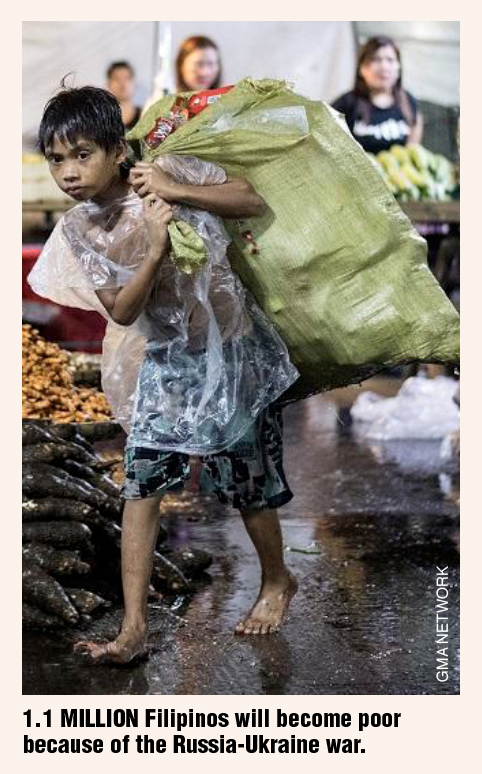The global economic situation has turned for the worse. The world’s economic growth will slow down this year.
This year, more people will be hungry or hungrier, and more will be poor and poorer still. For three reasons: one, the war in Ukraine which is turning into a devastating stalemate; two, record-high inflation rates not seen in the last 40 years in the United States and many countries; and three, the lingering effects of the worst pandemic in a century.
Global growth lower by 1%
Global growth this 2022 will be slashed sharply, by one percentage-point to 3.2%, from the 4.1% growth for the year projected by the World Bank last January.
The International Monetary Fund, in its April 2022 World Economic Report, is slightly more optimistic. It projects global growth of 3.6%, both for 2022 and 2023—0.8 and 0.2 percentage point lower than its January forecast, respectively. “The downgrade largely reflects the war’s direct impacts on Russia and Ukraine and global spillovers,” explains the Fund.
The 3.6% global growth is 0.4 higher than the World Bank’s 3.2% forecast. The 0.4% difference is not minuscule. It is equivalent to $356 billion. Each percentage point of global growth is equivalent to $890 billion, assuming global GDP of $89 trillion a year.
Global output down by $2.22 trilion
In 2021, the world grew by a respectable 5.7%. So from 5.7% last year to only 3.2% this year is a precipitous drop in growth of 2.5 percentage points, a loss of $2.225 trillion in world economic output.

Just how big is one billion dollars? If you try to save $100 a day to reach $1 billion, it will take you 27,397 years to do it. Considering that the average Filipino life span is 69 years, you need 397 lifetimes to save $1 billion.
According to the World Bank, if the Ukraine war worsens, some 1.1 million Filipinos will be poor. Why? Because food prices will rise astronomically.
Outlook for Asian economies
Says the World Bank reporting on the 2022 outlook for Asian economies this April: “Shocks emanating from the war in Ukraine and the related sanctions could affect the East Asia and the Pacific region most concretely by disrupting the supply of commodities, as well as by increasing financial stress and reducing global confidence.
Asia’s “direct dependence on Russia and Ukraine through imports and exports of goods, services, and capital, is limited. But the war and sanctions are likely to increase international prices of food and fuel, hurting consumers and growth.”
“The number of poor in the Philippines, for example, could increase by one percentage point, or 1.1 million measured at the lower-middle-class poverty line ($3.2/day) if cereal prices rise by an average of 10% over the year.”
PH growth could only be 5.7% at best
In October 2021, the World Bank forecast 2022 Philippine growth to be 5.8%. This April, the bank revised its forecast Philippine growth to be 5.7% this year, at best, and 4.9%, at worst. These 5.7 and 4.9% growth rates are far below the 7 to 9% GDP rates forecast by the Duterte government for this year.
Just as Asia was about to lick the COVID pandemic, the World Bank says three clouds have gathered over the economic horizon, which will mean lower economic growth and higher poverty.
One, the war in Ukraine is disrupting the supply of commodities, increasing financial stress, and dampening global growth. Two, the US inflation ignited by the stimulus-led rebound and persistent supply disruptions could provoke faster-than-anticipated financial tightening, perhaps timely in the US but too early in many Asian countries where recovery is incomplete.
Three, China’s structural slowdown, deleveraging of the real estate sector and CoViD-19 resurgence amidst zero-COVID policies, could dampen regional exports.
The IMF says “the war in Ukraine has triggered a costly humanitarian crisis that demands a peaceful resolution.”
“War-induced commodity price increases and broadening price pressures have led to 2022 inflation projections of 5.7% in advanced economies and 8.7% in emerging market and developing countries,” reports the IMF. In January this year, IMF projected 2022 inflation in rich countries to be 3.9% and in emerging economies (which includes the Philippines), to be 5.9%.
In addition to the war, notes the IMF, “frequent and wider-ranging lockdowns in China—including in key manufacturing hubs—have also slowed activity there and could cause new bottlenecks in global supply chains. Higher, broader, and more persistent price pressures also led to a tightening of monetary policy in many countries.”
Tighter monetary policy
A tighter monetary policy means higher interest rates. Higher interest rates in turn lead to higher cost of capital and higher cost of doing business. Higher commodities prices and higher cost of doing business mean higher inflation rates. And higher inflation rates mean lower purchasing power and more number of people being impoverished.
That number, reckons the World Bank, is equivalent to 1.1 million Filipinos poorer this year.
– Tony Lopez
